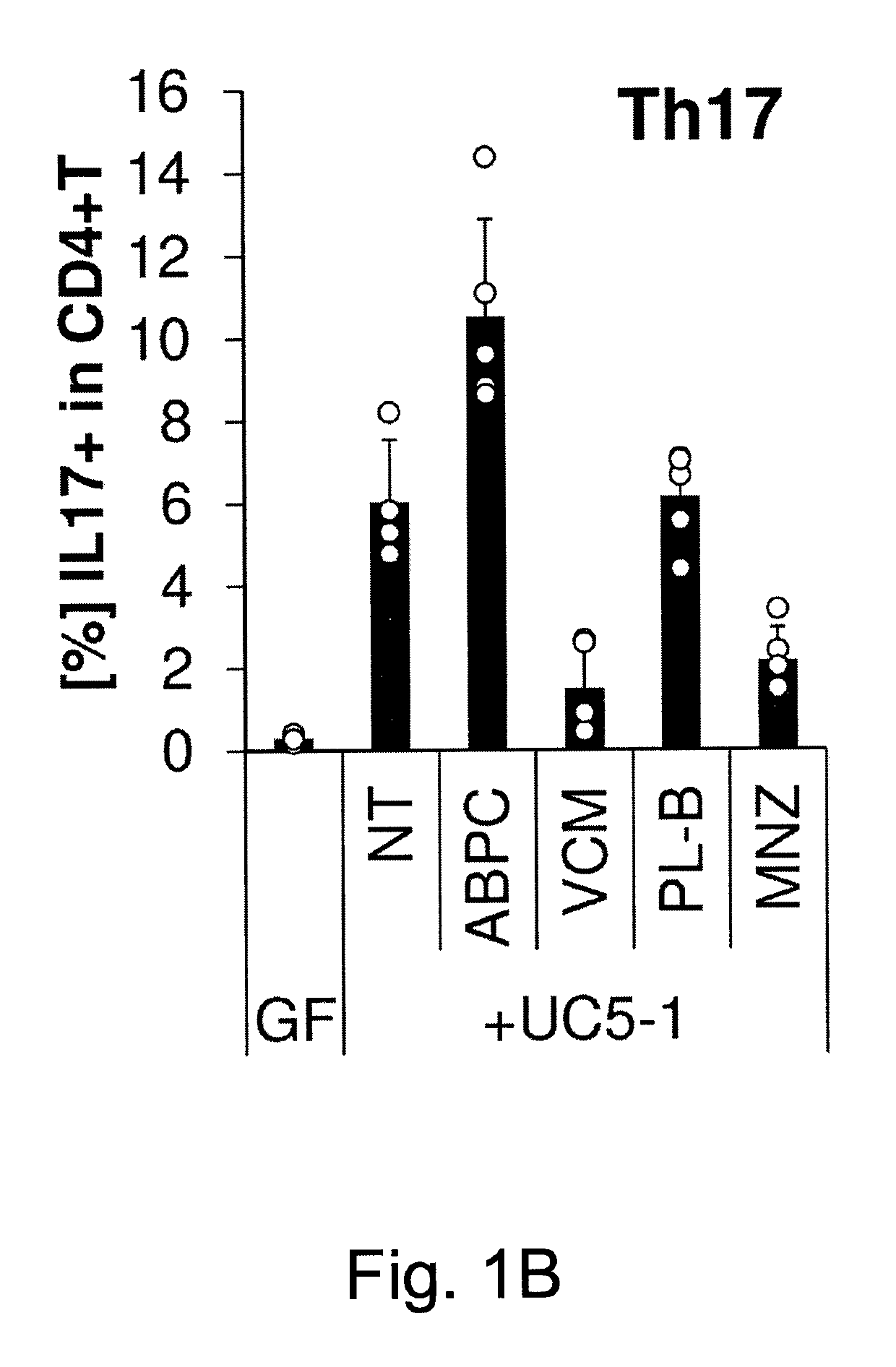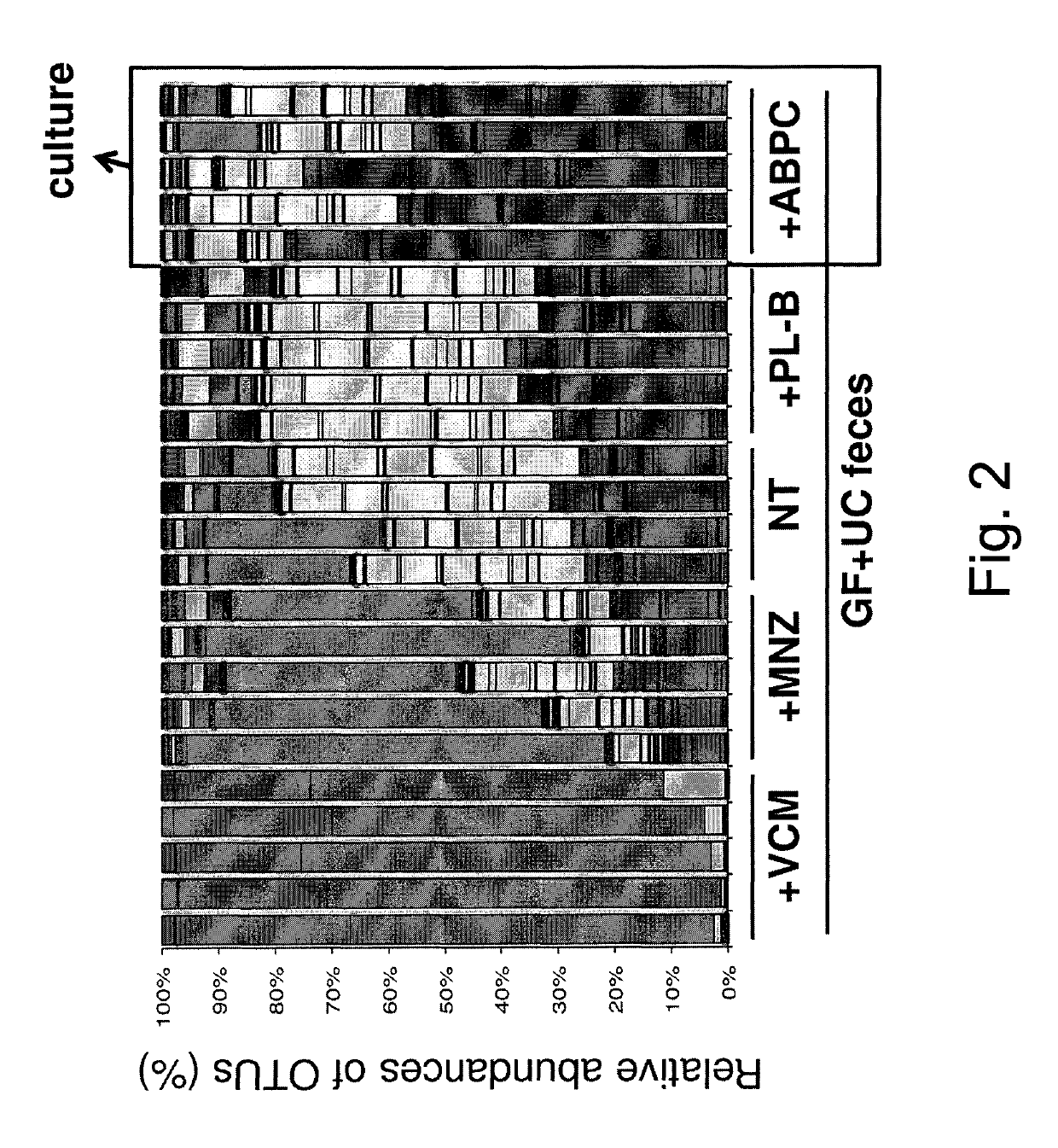Compositions and methods for induction of TH17 cells
a technology of th17 cells and induction methods, applied in the field of th17 cell induction, can solve the problems of over-strength or insufficient immune robustness, and achieve the effects of reducing the risk of infection, and improving the immune function
- Summary
- Abstract
- Description
- Claims
- Application Information
AI Technical Summary
Benefits of technology
Problems solved by technology
Method used
Image
Examples
example 1
[0095]Human stool (2 g) from an ulcerative colitis (UC) Japanese patient in a clinically active state was suspended with 8 ml phosphate-buffered saline (PBS) containing 20% glycerol, snap-frozen in liquid nitrogen, and stored at −80° C. until use. The frozen stock was thawed, and orally inoculated into IQI germ-free (GF) mice (250 μl / mouse). The mice were given ampicillin (ABPC; 1 g / L), vancomycin (VCM; 500 mg / L), polymyxin B (PL-B; 200 mg / L), metronidazole (MNZ; 1 g / L), or water only (non-treated: NT) in their drinking water beginning 1 d after the inoculation with UC patient feces until the day of analysis. Each group of ex-GF mice (n=5 for each group) was separately kept in a vinyl isolator for 4 weeks.
[0096]The colons were collected and opened longitudinally, washed with PBS to remove all luminal contents and shaken in Hanks' balanced salt solution (HBSS) containing 5 mM EDTA for 20 min at 37° C. After removing epithelial cells, muscle layers and fat tissue using forceps, the la...
example 2
[0099]The caecal contents from each exGF mice described in Example 1 were suspended in 10 mL of Tris-EDTA containing 10 mM Tris-HCl and 1 mM EDTA (pH 8), and incubated with Lysozyme (SIGMA, 15 mg / mL) at 37° C. for 1 h with gentle mixing. A purified achromopeptidase (Wako) was added (final concentration 2000 unit / mL) and incubated at 37° C. for another 30 min. Then, sodium dodecyl sulfate (final concentration 1%) was added to the cell suspension and mixed well. Subsequently, proteinase K (Merck) was added (final concentration 1 mg / mL) to the suspension and the mixture was incubated at 55° C. for 1 h. High-molecular-weight DNA was isolated and purified by phenol / chloroform extraction, ethanol, and finally polyethyleneglycol precipitation. PCR was performed using Ex Taq (TAKARA) and (i) modified primer 8F [5′-CCATCTCATCCCTGCGTGTCTCCGACTCAG (454 adaptor sequence, SEQ ID NO.: 21)+Barcode (10 bases)+AGRGTTTGATYMTGGCTCAG (SEQ ID NO.: 22)-3′] and (ii) modified primer 338R [5′-CCTATCCCCTGTGT...
example 3
[0102]To investigate whether the isolated 20 strains (Table 1) have the ability to induce Th17 cells, all 20 strains were cultured and mixed to make a cocktail, and the cocktail was orally inoculated into GF mice. The isolated 20 strains were individually cultured in Schaedler or PYG broth under a strictly anaerobic condition (80% N2, 10% H2, 10% CO2) at 37° C. in an anaerobic chamber (Coy Laboratory Products), and then mixed at equal amounts of media volume to prepare the bacterial mixture. The aliquot of bacterial mixture was orally inoculated into mice (0.5 ml / mouse). After 4 weeks, the colons and small intestines were collected and analyzed for Th17 and Th1 cells. The percentages of IL-17+ cells and IFN-g+ within the CD4+ T cell population in the colon lamina propria and small intestine lamina propria of the indicated mice are shown in FIG. 3. In mice colonized with the 20 strains, a strong induction of Th17 cells was observed.
[0103]SEQ ID Nos.: 2H6, 1B11, 1D10, 2E3, 1C12, 2G4, ...
PUM
| Property | Measurement | Unit |
|---|---|---|
| transit time | aaaaa | aaaaa |
| concentration | aaaaa | aaaaa |
| composition | aaaaa | aaaaa |
Abstract
Description
Claims
Application Information
 Login to View More
Login to View More - R&D
- Intellectual Property
- Life Sciences
- Materials
- Tech Scout
- Unparalleled Data Quality
- Higher Quality Content
- 60% Fewer Hallucinations
Browse by: Latest US Patents, China's latest patents, Technical Efficacy Thesaurus, Application Domain, Technology Topic, Popular Technical Reports.
© 2025 PatSnap. All rights reserved.Legal|Privacy policy|Modern Slavery Act Transparency Statement|Sitemap|About US| Contact US: help@patsnap.com



